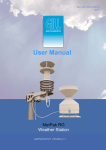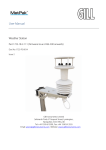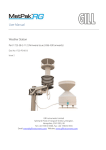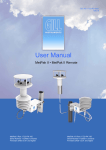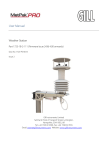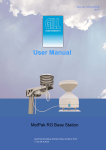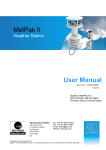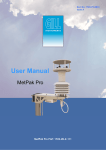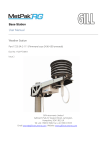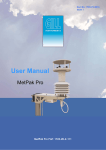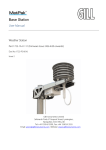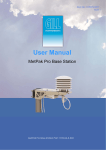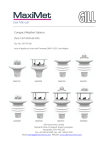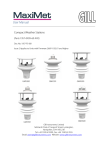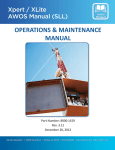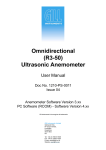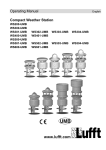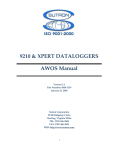Download User Manual MetPak
Transcript
Doc No: 1723-PS-0014
Issue A
User Manual
MetPak
MetPak Part: 1723-1B-2-111
Foreword
© 2010 Gill Instruments Ltd. All rights reserved.
Thank you for purchasing the MetPak manufactured by Gill Instruments Ltd. To
achieve optimum performance we recommend that you read the whole of this
manual before proceeding with use.
Gill products are in continuous development and therefore specifications may be
subject to change and design improvements without prior notice.
The information contained in this manual remains the property of Gill Instruments
and should not be copied or reproduced for commercial gain.
Guarantee
For terms of guarantee, please contact your supplier.
Warranty is void if the coloured Wind Sensor security seal is damaged or broken,
or the Wind Sensor transducer caps have been damaged.
Trademarks
Microsoft and Windows are registered trademarks of Microsoft Corporation.
All other brands and product names are trademarks or registered trademarks of
their respective owners.
Cautions and Notes
The following symbols are used in this guide:
CAUTION. This indicates an important operating instruction that should be
followed to avoid any potential damage to hardware or property, loss of data,
or personal injury.
NOTE. This indicates important information to help you make the best use of this
product.
Applicable Parts
MetPak Part 1723-1B-2-111
Contents
1.
Introduction ......................................................................................................... 1
1.1
1.2
2.
Principle of Operation...................................................................................................... 2
1.1.1
Wind Speed and Direction Sensor ..................................................................... 2
1.1.2
Radiation Shield ................................................................................................ 3
1.1.3
Temperature and Relative Humidity Sensor with Dewpoint Output .................... 3
1.1.4
Barometric Pressure.......................................................................................... 3
Abbreviations .................................................................................................................. 4
Installation .......................................................................................................... 5
2.1
2.2
3.
Pre-Installation Checks ................................................................................................... 5
2.1.1
Spare Parts ....................................................................................................... 5
Installation....................................................................................................................... 6
2.2.1
Bench system test ............................................................................................. 6
2.2.2
Equipment Required .......................................................................................... 6
2.2.3
Cabling .............................................................................................................. 6
2.2.4
Communication connections.............................................................................. 9
2.2.5
Mounting MetPak ............................................................................................ 13
Operation ........................................................................................................... 15
3.1
3.2
3.3
Start Guide.................................................................................................................... 15
MetView ........................................................................................................................ 16
3.2.1
Opening MetView ............................................................................................ 16
3.2.2
Scanning for Devices....................................................................................... 17
3.2.3
The MetView Console ..................................................................................... 18
3.2.4
MetView Console Display Options ................................................................... 19
3.2.5
MetView Gauge Ranges and Graphs .............................................................. 20
3.2.6
Data logging .................................................................................................... 22
Configuring MetPak....................................................................................................... 25
3.3.1
Configuring MetPak using MetSet ................................................................... 27
3.3.2
MetSet Editing Screen ..................................................................................... 29
3.3.3
Configuring MetPak using HyperTerminal ....................................................... 34
3.3.4
Configuring MetPak for NMEA Output. ........................................................... 39
3.3.5
Configuring MetPak for SDI-12 ....................................................................... 40
3.3.6
SDI-12 Commands .......................................................................................... 40
3.3.7
Safe Mode ....................................................................................................... 43
Last Change
08 February, 2013
MetPak User Manual
© Gill Instruments Ltd
Page i
Contents
4.
Troubleshooting ................................................................................................ 45
4.1
Fault-Finding ................................................................................................................. 45
4.2
Servicing
4.3
Bench Tests
....................................................................................................................... 46
.................................................................................................................. 46
5.
Maintenance ...................................................................................................... 47
6.
Technical Information ....................................................................................... 49
6.1
6.2
6.3
Specification ................................................................................................................. 49
Hub PCB Connections .................................................................................................. 51
Electrical Conformity Certificate .................................................................................... 52
Figures
Figure 1 MetPak
Figure 2 Compass points
Figure 3 Position of Temperature and Relative Humidity Probe in the Radiation Shield
Figure 4 Internal view of the MetPak
Figure 5 Connection of Gill USB Cable (Part No. 1723-10-051)
Figure 6 RS232 connections
Figure 7 RS422 connections
Figure 8 RS485 Connections
Figure 9 SDI-12 connections
Figure 10 Correct mounting position for MetPak
Figure 11 Opening MetView Screen
Figure 12 Scanning for MetPak Devices
Figure 13 The MetView Console
Figure 14 MetView Gauge Range
Figure 15 MetView Graph
Figure 16 Setting up data logging
Figure 17 A typical data log (viewed in Windows Notepad)
Figure 18 Opening MetSet Screen
Figure 19 Summary of MetPak Device Settings using MetSet
1
2
3
9
10
10
11
11
12
14
16
17
18
20
21
22
24
27
28
Tables
Table 1
Table 2
Table 3
Table 4
Table 5
Table 6
Table 7
Table 8
Table 9
Table 10
Abbreviations
Recommended Belden cable types
Maximum cable lengths for supported communication networks
Connection status indicators
MetView scale and unit options
MetView averaging options
Max/min markers
MetView Screen Settings Options
Default configuration settings
MetPak configuration commands
MetPak User Manual
© Gill Instruments Ltd
Page ii
4
7
7
18
19
19
19
19
25
35
Last Change
08 February, 2013
Table 11
Table 12
Table 13
Table 14
Table 15
Table 16
Abbreviations used in UNIT configuration command
Common problems and their solution
Status codes as output with the MetPak data string
HygroClip connections (6-way connector J1)
MetPak WindSonic anemometer connections (8-way connector J4)
PC communications (8-way connector, J5)
MetPak User Manual
© Gill Instruments Ltd
Page iii
38
45
46
51
51
51
Last Change
08 February, 2013
1. Introduction
MetPak
MetPak is a compact and lightweight multi-sensor instrument that measures the
most essential weather parameters. Gill ultrasonic technology, as used in the
proven WindSonic instrument, measures wind speed and direction. Temperature
and Humidity are measured and Dewpoint calculated using an industry standard
probe housed in a naturally aspirated radiation shield. Barometric pressure is
measured using an industry standard sensor.
The instrument is supplied with digital ASCII RS232/RS422/485 (2 wire point to
point) and digital SDI-12 outputs. NMEA 0183 output is also configurable. An
electrical hub box is fitted to the mounting bracket allowing convenient termination
of all electrical cables.
The instrument uses a rugged mounting clamp that attaches to any vertical pipe
from 30mm to 58mm (2.3”) diameter.
An electrical hub box is fitted to the mounting bracket for termination of data and
power cables.
Wind speed and
direction sensor
Radiation shield
Gore-Tex Vent for
Barometric
Pressure Sensor
Temperature and
Relative humidity
sensor
Hub box
Mounting
bracket
Figure 1
Last Change
08 February, 2013
MetPak
MetPak User Manual
© Gill Instruments Ltd
Page 1
Introduction
1.1
Principle of Operation
1.1.1
Wind Speed and Direction Sensor
The MetPak uses the WindSonic wind speed and direction sensor. The WindSonic
measures the times taken for an ultrasonic pulse of sound to travel from the North
transducer to the South transducer, and compares it with the time for a pulse to
travel from S to N transducer. Likewise times are compared between West and
East, and E and W transducer.
If, for example, a North wind is blowing, then the time taken for the pulse to travel
from N to S will be faster than from S to N, whereas the W to E, and E to W times
will be the same. The wind speed and direction can then be calculated from the
differences in the times of flight on each axis. This calculation is independent of
factors such as temperature.
Figure 2 Compass points
Figure 3 shows the compass point and polarity of U and V if the wind components
along the U and V axis are blowing in the direction of the respective arrows.
MetPak User Manual
© Gill Instruments Ltd
Page 2
Last Change
08 February, 2013
Introduction
1.1.2
Radiation Shield
The Multi-Plate Radiation Shield protects temperature and relative humidity
sensors from error-producing solar radiation and precipitation. This shield relies on
a combination of plate geometry, material and natural ventilation to provide
effective shielding.
1.1.3
Temperature and Relative Humidity Sensor with
Dewpoint Output
The Rotronic HygroClip module is a complete instrument, with integrated
temperature compensation. Calibration data is maintained within the integrated
electronics. It provides digital output signals for Relative Humidity, Temperature
and Dewpoint to the MetPak Hub box.
Figure 3
Shield
1.1.4
Position of Temperature and Relative Humidity Probe in the Radiation
Barometric Pressure
Barometric pressure output is provided by a solid-state device fitted on to the circuit
board in the MetPak hub box. Vent to atmosphere is via a Gore-Tex® filter, which
protects the pressure sensor from the effects of wind and rain.
Last Change
08 February, 2013
MetPak User Manual
© Gill Instruments Ltd
Page 3
Introduction
1.2
Abbreviations
Table 1 Abbreviations
Item
ASCII
C
CAL
CD
COM
CR
CSV
ETX
F
FPM
HF
HPA
HTML
Hz
IMM
In Hg
K
KPH
KTS
LF
M Bar
Max
MF
Min
Mm Hg
MPH
MS
MS
NMEA
NSEW
NVM
PC
ROM
RS232
RS422
Rx
RXD
SDI-12
STX
Tx
TXD
VHF
WIMWV
WIXDR
WMO
Meaning
American Standard Code for Information Interchange
Centigrade
Calibration
Compact Disc
Communications
Carriage Return
Comma Separated Variable
End of String
Fahrenheight
Feet per Minute
High Frequency
Hecto-Pascals
Hyper Text Markup Language
Hertz
International Maritime Mobile
Inches of Mercury
Kelvin
Kilometres per Hour
Knots
Line Feed
Milli Bars
Maximum
Medium Frequency
Minimum
Millimetres of Mercury
Miles per Hour
Microsoft
Metres per Second
National Marine Electronics Association
North South East West
Non-Volatile Memory
IBM compatible Personal Computer
Read Only Memory
Communications standard
Communications standard
Receive
Received Data
Serial – Data Interface standard for microprocessor based
sensors
Start of String
Transmit
Transmitted Data
Very High Frequency
Wind Instrument Mean Wind direction and Velocity
Wind Instrument Cross track error Dead Reckoning
World Meteorological Organisation
MetPak User Manual
© Gill Instruments Ltd
Page 4
Last Change
08 February, 2013
Installation
2. Installation
MetPak has been designed to meet and exceed the stringent standards listed in its
specification (see Para 6.1).
2.1
Pre-Installation Checks
As with any sophisticated electronics, good engineering practice should be
followed to ensure correct operation:
2.1.1
Last Change
08 February, 2013
Ensure the MetPak will not be affected by other equipment operating
locally, which may not conform to current standards, e.g. radio/radar
transmitters, generators etc.
Avoid mounting in the plane of any radar scanner – a vertical separation of
at least 2m should be achieved.
When installing MetPak near radio transmitting antennas, ensure that the
mounting position fulfills the following minimum separations (all round):
VHF IMM – 1m
MF/HF – 5m
Satcom – 5m (avoid likely lines of sight)
Use cables recommended by Gill (see Para 2.2.3). If cables are cut and reconnected incorrectly (perhaps in a junction box) then EMC performance
may be compromised if cable screen integrity is not maintained.
Avoid earth loops – wire the system in accordance with these installation
guidelines.
Ensure that the power supply operates to the MetPak specification (see
Para 6.1) at all times.
Avoid turbulence caused by surrounding structures that will affect the
accuracy of the sensors such as trees, masts and buildings. The WMO
make the following recommendations. The standard exposure of wind
instruments over level open terrain is 10m above the ground. Open terrain
is defined as an area where the distance between the sensor and any
obstruction is at least 10 times the height of the obstruction.
Keep away from building exhaust vents, machinery and motors.
Spare Parts
1723-10-051
RS232 to USB 1.8M configuration cable.
1723-PK-024
Pressure Sensor Filter Spares kit.
1723-PK-025
Hygroclip Filter Replacement Kit (2 Filters).
MetPak User Manual
© Gill Instruments Ltd
Page 5
Installation
2.2
Installation
2.2.1
Bench system test
Prior to physically mounting the MetPak in its final location, we strongly
recommend that a bench system test is carried out to confirm the system is
configured correctly, is fully functional and electrically compatible with the selected
host system and cabling (preferably utilising the final cable length). The required
data format, units, output rate, and other options should also all be set up at this
stage.
2.2.2
Equipment Required
1723-1B-2-111 MetPak set for RS232 communication (factory default setting).
1723-10-051
MetPak RS232 to USB 1.8M configuration cable with integral 5v
power or alternatively use RS232, RS232 converter and separate
5v to 30 dc power supply.
ES-U-1001-A
EasySynch RS232 to USB adaptor or equivalent (if not using Gill
part 1723-10-051) or connect directly to an RS232 COM port.
Power Supply 5V to 30Vdc at 50mA if required.
Belden 9503 3 pair cable (if not using Gill Part 1723-10-051), length as required.
Gill MetView Software supplied on the MetPak CD or download from
.http://www.gill.co.uk/main/software.html
2.2.3
Cabling
Communication Cabling
MetPak has five communication connection options:
USB (using the 1.8m Gill USB cable, Part No. 1723-10-051).
RS232
RS422
RS485 (two wire point to point)
SDI-12
It is important that the cable is appropriate for the chosen communication network.
The following sections describe the recommended types and maximum lengths of
cable in each case.
NOTE. A 15-metre, 6-pair cable (wires stripped at each end) suitable for
RS232/RS422/485 or SDI-12 communication is available from Gill Instruments
(Part No. 1723-10-053).
MetPak User Manual
© Gill Instruments Ltd
Page 6
Last Change
08 February, 2013
Installation
Cable Type
Wire type:
24AWG
Wire size:
7x32 AWG.
Cable outer diameter:
6-8mm (to match the hub box gland).
For RS422/485 operation the cable should contain twisted pairs screened to match
the application.
The following table shows an example manufacturers’ reference; other
manufacturers’ equivalents can be used.
Table 2 Recommended Belden cable types
Application
No. of Pairs
SDI-12 or RS485
2
Belden Ref.
9729
Digital RS232
3
9503
Digital RS422
4
9504
Cable length
The maximum cable length is dependent on the chosen communication method.
The following table shows the maximum cable lengths for the supported
communication protocols at the given baud rates, using the recommended cable. If
any problems of data corruption etc are experienced, then a slower baud rate
should be used. Alternatively, a higher specification cable can be tried.
Table 3 Maximum cable lengths for supported communication networks
Communication format
Baud rate
Max. cable length
RS232
19200
6.5M
RS422/RS485
19200
1000M
SDI-12
1200
90M
Cabling (unused wires)
Any unused wires in the connecting cables should be connected to ground
preferably at the user equipment end.
Cabling protection
The Cable should be secured:
With cable clamps or equivalent at regular intervals such that the hub
box cable gland does not support the cable weight.
Away from the mounting bolts to prevent chaffing of the cable.
NOTE. Install appropriate strain relief support to the cable. If possible, pass the
cable through the mounting pole.
Last Change
08 February, 2013
MetPak User Manual
© Gill Instruments Ltd
Page 7
Installation
Earthing
To ensure correct operation and for maximum protection from lightning, a separate
lightning rod system is recommended to protect the system.
You can also earth the MetPak through its mountings or by connecting a grounding
cable (minimum of 6mm² copper wire) to a spare MetPak metalwork bolt hole.
Clean off any paint that might prevent a good connection.
When you connect the communications cable ensure that the screen has a
connection to the hub box case.
Routing Cables through the Hub Box Glands
NOTE: The MetPak Hub Box cable glands contain spring loaded metal leaves that
are designed to make a ground contact with cables that have an overall braid
screen. Care is therefore required when inserting and removing cables through the
glands to prevent damage to the metal leaves.
MetPak User Manual
© Gill Instruments Ltd
Page 8
Last Change
08 February, 2013
Installation
2.2.4
Communication connections
To connect MetPak:
1.
Open MetPak hub box by unfastening the four screws.
2.
Locate connector J5 (see Figure 4). Carefully pull the connector off its circuit
board pins.
3.
Strip the cable wires to 8mm.
4.
Pass the cable through one of the gland nuts.
5.
Connect your cable as shown in the following diagrams:
Gill USB Cable
Figure 5
RS232
Figure 6
RS422
Figure 7
RS485
Figure 8
SDI-12
Figure 9
6.
Ensure the cable screen is grounded through the hub box gland metalwork.
7.
After connection, securely tighten the gland nut to prevent moisture ingress.
NOTE. Ensure that MetPak is configured for the chosen communications method.
J4 Pin 1
J1 Pin 6
Figure 4
Last Change
08 February, 2013
J5 Pin 8
J5 Pin 1
Hex Terminal
Post
J5, showing RS232 to USB
Configuration Cable Wires
Internal view of the MetPak
MetPak User Manual
© Gill Instruments Ltd
Page 9
Installation
USB Lead Connection (COMMS set for RS232)
Connect to
Hub box J5
Connecting MetPak to a PC USB port using the Gill Configuration Cable 1723-10-051.
J5 Pin
1
2
3
4
5
6
7
8
Colour
None
None
Yellow
Orange
None
None
Black
Red
Figure 5
Connection of Gill USB Cable (Part No. 1723-10-051)
NOTE:- If upon connecting the USB lead to a PC the driver is not found by the PC, then
the appropriate driver to match the PC Windows version may be downloaded from:http://www.ftdichip.com/Drivers/VCP.htm
Digital Output RS232 Connections (COMMS set for RS232)
This is the MetPak default communication configuration setting.
J5 Hub Box
8 Way Push fit Block
Pin nos.
Signal names
Figure 6
3 Pair Cable
Pin
No’s
Signal
Names
RS232 TX
RS232 RX
3
4
2
3
RXD
TXD
Signal Ground
2
5
Sig Gnd
Chassis
Ground
Terminal
Post
NA
Chassis
Gnd
Supply -ve
Supply +ve
7
8
Screen wires
–
+
DC Power
supply
RS232 connections
MetPak User Manual
© Gill Instruments Ltd
Page 10
PC 9 Way D Type
Connector
Last Change
08 February, 2013
Installation
Digital Output RS422 Connections (COMMS set for RS422)
This is not the default communications setting; ensure the MetPak has been
configured for this output requirement before wiring to a user device.
J5 Hub Box
8 Way Push fit Block
Terminal
Signal Names
Nos.
Figure 7
RS422 to RS232
or USB Converter
4 Pair Cable
Signal Names
RS422 TX +
RS422 TX –
RS422 RX +
RS422 RX –
6
3
5
4
RX +
RX –
TX +
TX –
Signal Ground
2
Signal Ground
Chassis
Ground
Terminal
Post
Supply –ve
Supply +ve
7
8
Screen wires
Chassis ground
–
+
DC Power
Supply
RS422 connections
Digital Output RS485S 2 Wire Point to Point Connections
(COMMS set for RS485P2W)
This is not the default communications setting; ensure the MetPak has been
configured for this output requirement before wiring to a user device.
Note that is not possible to network other devices on this 2-wire RS485 link.
J5 Hub Box
8 Way Push fit Block
Terminal
Signal Names
Nos.
Figure 8
Last Change
08 February, 2013
RS485 to RS232
or USB Converter
2 Pair Cable
Signal Names
RS485 TX +
RS485 RX+
RS485 TX –
RS485 RX –
6
5
3
4
RS485TX/RX+
Signal Ground
2
Signal Ground
Chassis
Ground
Terminal
Post
Supply -ve
Supply +ve
7
8
RS485TX/RX–
Screen wires
Chassis ground
–
+
DC Power
Supply
RS485 Connections
MetPak User Manual
© Gill Instruments Ltd
Page 11
Installation
Digital Output SDI-12 Connections (COMMS set for SDI-12)
This is not the default communications setting; ensure the MetPak has been
configured for this output requirement before wiring to a user device.
J5 Hub Box
8 Way Push fit Block
Terminal
Signal Names
Nos.
SDI-12
Signal Ground
Figure 9
2 Pair Cable
Signal Names
1
2
Chassis Ground
Terminal
Post
Supply -ve
Supply +ve
7
8
SDI-12
Signal Ground
Screen wires
Chassis ground
–
+
DC Power
Supply
SDI-12 connections
MetPak User Manual
© Gill Instruments Ltd
Page 12
SDI-12 Device
Last Change
08 February, 2013
Installation
2.2.5
Mounting MetPak
MetPak uses a mounting clamp suitable for attaching to a vertical pipe with a
diameter of 30-58mm. When mounting the MetPak, consider the position,
orientation and alignment of the unit.
Note that the mounting pipe should first be degreased and when assembling the
MetPak clamp assembly the outer clamp nuts need to be tightened evenly to a
torque figure of 3 Nm.
The moving plate part of the clamp needs to be reversed for poles below 38 mm
diameter.
Position
It is the responsibility of the customer to ensure that the MetPak is mounted in a
position clear of any structure, including the mounting post, which may obstruct the
airflow or induce turbulence.
CAUTION. Do NOT mount the MetPak in close proximity to high-powered
radar or radio transmitters. A site survey may be required if there is any
doubt about the strength of external electrical noise.
The temperature and humidity probe is mounted inside the radiation shield as
shown in Figure 3.
Orientation
Normally, the MetPak is mounted on a vertical pole, ensuring a horizontal
Measuring Plane, (see Figure 10).
For indoor use the unit may be mounted with the Measurement Plane set to any
required orientation.
Alignment
The MetPak Wind Sensor should be aligned to point to North, or any other
reference direction – for example, the bow of a boat.
There are two arrows, a coloured rectangle, and an alignment notch to aid
alignment.
Note. It is usually simpler to work first with a compass at ground level and identify a
suitable landmark and it’s bearing.
Interference
Always check the installation to ensure the MetPak is not affected by other
equipment operating locally, which may not conform to current standards, e.g.
radio/radar transmitters, boat engines, generators etc.
See Para 2.1 for guideline details.
Last Change
08 February, 2013
MetPak User Manual
© Gill Instruments Ltd
Page 13
Installation
Figure 10
Correct mounting position for MetPak
Note that the mounting pipe should first be degreased and when assembling the
MetPak clamp assembly the outer clamp nuts need to be tightened evenly to a
torque figure of 3 Nm.
The moving plate part of the clamp needs to be reversed for poles below 38 mm
diameter.
Suitable Pole Diameter 30mm to 58mm (1.2 to 2.3 inches).
MetPak User Manual
© Gill Instruments Ltd
Page 14
Last Change
08 February, 2013
3. Operation
This section provides an overview of the installation and operation of MetPak. For
more detailed information about any of the steps, use the references to other
sections of this manual.
3.1
Start Guide
Decide how you are going to connect MetPak to your PC or communications
network. MetPak supports the following options:
USB connection using Gill’s RS232 to USB 1.8M configuration cable
(includes integral 5V power supply). To order, contact your dealer
quoting part number: 1723-10-051).
NOTE. You could use an equivalent RS232-USB adapter such as
EasySynch RS232 to USB adaptor.
RS232 connection using standard cable and PC COM port. Separate
5V to 30V dc power supply also required.
RS422 using RS232 converter.
RS485 2 wire point-to-point communication using suitable converter
(note RS485 2 wire point-to-point is not compatible with MetView
Software).
SDI-12 connection (note SDI-12 is not compatible with MetView
Software).
NOTE. MetPak is pre-configured for RS232 communication (factory
setting). If you want to use an alternative communication protocol, you
will need to set up the unit using an RS232 connection (with an
appropriately wired cable), change the setting), shut the unit down,
attach a cable for the new communication type, and then restart the
unit.
1.
Unpack MetPak. Check that you have the following:
MetPak unit (Part No. 1723-1B-2-111).
Gill MetView, MetSet Software and Manual supplied on the CD.
If any parts are missing, please contact your dealer.
Last Change
08 February, 2013
2.
Open the hub box by unfastening the four retaining screws. Locate the
connector: J5 (see Figure 4). Carefully pull the connector block from its pins.
3.
Prepare the communications cable by stripping the wires to a length of 8mm.
Feed the prepared cable through one of the two available ports on the side
of the hub box.
4.
Connect the cable to J5 as described on page 9 for your chosen
communications method.
5.
Carefully press J5 onto its circuit board pins.
6.
Replace the top on the connection box. Tighten the gland on the connection
port to seal the cable in place.
MetPak User Manual
© Gill Instruments Ltd
Page 15
Operation
3.2
7.
If you are carrying out a bench test, continue to step 13. When you have
finished testing, return to Step 10.
8.
Ensure that if using a mounting pole that it has been degreased in the area
where the MetPak will be positioned.
9.
Position the MetPak against the mounting post (see page 13), fit the
mounting kit bracket and tighten sufficiently to hold the unit in place but
allowing it to be rotated or moved up and down the pole.
10.
Check the orientation and alignment of the unit (see page 13).
11.
Check the height of the unit and ensure it is clear of any obstructions,
including the mounting post, that could interfere with MetPak’s
measurements (see page 13).
12.
Tighten the mounting bracket nuts evenly to a torque of 3Nm to hold the unit
firmly in place.
13.
Connect the communications cable to your PC or network device.
14.
Place the MetPak CD in your PC’s CD drive and install MetView.
MetView
MetView Software allows you to view the MetPak data graphically and has a
simple data logging facility.
Before you can use MetView, check that MetPak is correctly connected to a COM
or USB port on your PC (see Para 2.2.4).
NOTES:
MetView is compatible with RS232 and RS422 connected units only.
MetView will not read NMEA data strings.
3.2.1
Opening MetView
Click on the MetView button on your PC’s desktop or choose:
Start > Programs > MetView > MetView
The MetView Control Centre window is displayed
Scan Button– If MetPak transmit and receive wires are connected to the PC then
use the Scan button to connect to MetView.
Connection is Receive Only Tick Box – Use if the MetPak connection to the PC
has only transmit wires connected and a MetSet version of its current device
settings is available to upload to MetView. Select ‘Connection is Receive only’ tick
box and click on the Scan button. Upload a MetSet generated Device file from a
PC location as directed.
Figure 11
Opening MetView Screen
MetPak User Manual
© Gill Instruments Ltd
Page 16
Last Change
08 February, 2013
Operation
3.2.2
Scanning for Devices
To set up communicate between MetView and a connected MetPak:
1.
Figure 12
Click on the Scan button to search the available COM ports for MetPak
devices.
Scanning for MetPak Devices
When a device is found, MetView obtains the MetPak configuration settings and
then retrieves and displays MetPak data.
Last Change
08 February, 2013
MetPak User Manual
© Gill Instruments Ltd
Page 17
Operation
3.2.3
The MetView Console
When connected correctly, MetView displays its data-monitoring console. This
consists of five gauges showing: Temperature, Humidity, Pressure, Wind Speed
and Wind Direction. There is also a digital readout of Dew Point. Buttons beneath
each of the gauges allow you to choose the displayed units and other options.
Each gauge also shows the maximum and minimum values recorded during the
current session. The wind speed gauge also shows the maximum gust speed.
Note: MetView will not show data if the unit is set for NMEA or SDI-12 formats.
Wind Direction
Wind Speed
Pressure
Humidity
Temperature
Disconnect
button
Dew Point
Averaging
options
Connection
Status
indicators
(see Table
below)
Firmware Version
and Unit ID
Load
Settings
button
Save
Settings
button
Default
Settings
button
Figure 13 The MetView Console
Logging
button
Max/Min
Markers
Connection Status
Table 4 Connection status indicators
Reading
Green Background Tick
Red Background Cross
1.00Hz
Thu 21 Jul 2011 15:51:07
Function
Indicates MetPak logging or communicating
correctly with MetView along with reading the
MetPak firmware version.
Indicates MetPak not logging or not
connected/communicating to MetView.
Indicates the output rate of the MetPak when
connected. Reads when the unit is communicating
correctly with MetView.
Real Time PC date and time indication.
MetPak User Manual
© Gill Instruments Ltd
Page 18
Last Change
08 February, 2013
Operation
3.2.4
MetView Console Display Options
MetView Console buttons can convert data from the MetPak to read different units
or scale settings. This does not alter the actual MetPak configuration.
Units shown in bold denote default settings
Table 5 MetView scale and unit options
Gauge
Wind Direction
Wind Speed Markers
Wind Speed
Pressure
Humidity
Temperature & Dew Point
Function
Use buttons to choose from two display styles:
NSEW or Maritime
Use buttons to add markers on the gauge for
Max/Min or Max Gust.
Use buttons to choose from five wind speed
units: m/s, kph, mph, kts, fpm
Use buttons to choose from pressure scales:
hPa, mbar, inHg, mmHg
Displays Max and Min values during current
session in %
Use buttons to choose from three temperature
scales: °C, °F, K
Table 6 MetView averaging options
Setting
Real Time
2 Min
10Min
Function
Choose this button for no averaging
Select for 2 minute rolling average of all sensor
readings
Select for 10 minute rolling average of all sensor
readings
Table 7 Max/min markers
Setting
Off
On
Reset
Function
Maximum and Minimum Markers on all gauges
turned off
Maximum and Minimum Markers on all gauges
turned on
Reset all Gauge Maximum/Minimum Markers
and all digital Maximum/Minimum reading at will
Table 8 MetView Screen Settings Options
Setting
Save Settings
Load Settings
Default Settings
Last Change
08 February, 2013
Function
Will Save all the current MetView screen
settings to a file for later retrieval if required.
Will load and update the MetView screen with a
previously saved setting.
Will return all MetView screen settings to factory
default.
MetPak User Manual
© Gill Instruments Ltd
Page 19
Operation
3.2.5
MetView Gauge Ranges and Graphs
Gauge Range Settings.
MetView Pressure, Humidity and Temperature Gauge ranges may be changed to
view changes in conditions more visibly.
Note, These changes only affect MetView settings and do not affect the MetPak
output.
For instance if the typical temperature measurement range required is from +10
degrees to +40 deg C then the temperature gauge range can be adjusted to reflect
this.
Place the mouse pointer over the Temperature display gauge and double click to
bring up the Set Gauge Range screen. Change Max and Min readings to required
values, e.g. +10 min and +40 max.
Click on Set.
The Temperature gauge range will be updated to reflect the change.
Double Click
to bring up
Set Gauge
Range.
Figure 14
MetView Gauge Range
MetPak User Manual
© Gill Instruments Ltd
Page 20
After
changing
the
Range.
Last Change
08 February, 2013
Operation
Graphs
MetView allows data detected over the last minute, last 1 hour and last 24 hours to
be accessed and shown on a graph.
Note. Data is only shown up to the time when the graph function is selected, the
graph is not updated once opened. Data is collected from the time that MetView is
opened and reading data from a MetPak.
Double Click on the
reading to bring up
the graph.
Click on the Last Min, Last Hour or Last 24 Hours buttons as required to view data.
Figure 15
Last Change
08 February, 2013
MetView Graph
MetPak User Manual
© Gill Instruments Ltd
Page 21
Operation
3.2.6
Data logging
NOTE. MetView logs data based on the MetPak configuration not on the MetView
console settings.
To log MetPak data, click on the Logging button on the MetView console. The
Logging dialog box is displayed.
Figure 16
Setting up data logging
Setting up a logging file
1.
Select Enable Logging to start logging to a file.
2.
Identify the name and location for the logging file:
3.
Log File location
Click on the Browse button to identify the folder
where you want to store the data file. Enter the name
of the file.
Log file header
If required type some notes on the data that is to be
recorded which will appear at the top of the saved
data log file.
Choose from the following additional options:
Log File Rotation
Set up segmented logging with each logged file length
determined by the number entered in the text box
below. The figure 3600, for example, means that each
log file length will be 3600 lines of data. Maximum
entries per log file is limited to 65535 and a maximum
of 2048 log files can be created.
Add Timestamp
Adds the date and time to the logged data file taken
from the PC clock.
MetPak User Manual
© Gill Instruments Ltd
Page 22
Last Change
08 February, 2013
Operation
To start logging
1.
Check that the Enable Logging option is selected.
2.
Click on the OK button to commence logging and return to the console.
Note. To show that data is being recorded, the Logging button’s icon changes to a
green tick:
Logging active
Logging stopped
To stop logging
To turn off logging:
Last Change
08 February, 2013
1.
Click on the Logging button on the MetView console. Clear the Enable
Logging check box.
2.
Click on the OK button. If logging has stopped, the Logging button shows a
red background cross instead of the green background tick (see above).
MetPak User Manual
© Gill Instruments Ltd
Page 23
Operation
Understanding logged data
Logged data is stored to a file with a .log extension. This can be viewed in any
text/HTML editor or spreadsheet application.
Figure 17
A typical data log (viewed in Windows Notepad)
Each entry in the default file format consists of the following:
000001 Thu Jun 17 16:08:53 2010, Q,113,000.07,1019.4,035.1,+024.7,+008.3,+04.9,00, 5F
Line Number
Date/time stamp
Node letter
Wind direction
Wind speed
Pressure
Humidity
Temperature
Dewpoint
Supply voltage
Status code
Checksum
MetPak User Manual
© Gill Instruments Ltd
Page 24
Last Change
08 February, 2013
Operation
3.3
Configuring MetPak
MetPak can be configured using:
Gill MetSet or a terminal program such as Windows HyperTerminal.
Gill Wind software used as a Terminal Program only.
The default configuration settings are listed in the following table.
Table 9 Default configuration settings
Setting
Function
Comms Levels
Baud Rate
Data Connection
Node ID
Output rate
Message Mode
ASCII Set Up
North Alignment
Sensor WindSpeed
Wind Speed Units
Temperature Sensor
Temperature Units
Dewpoint Sensor
Dewpoint Units
Pressure Sensor
Pressure Units
Humidity Sensor
Humidity Units
Report Format
RS232
19200
Data Bits 8, Parity None, Stop Bits 1, Flow Control None.
Q
1Hz
Continuous
Carriage return and line feed, Echo on
0
On
MS (Metres/Second)
On
C (Degrees Celsius)
On
C (Degrees Celsius)
On
Hecto Pascals
On
%
Node, Polar (Wind Direction and Wind Speed), Pressure,
Humidity, Temperature, Dewpoint, Volts, Status,
Checksum.
On
On
On
On
Comma Separated Variable
Status Message Output
Report Message Output
Units Message Output
Inputs Message Output
Output Sentence
Last Change
08 February, 2013
MetPak User Manual
© Gill Instruments Ltd
Page 25
Operation
Example Default ASCII Data String:
<STX>Q,170,000.08,1019.5,035.0,+024.7,+008.3,+04.9,00,<ETX>55 & (CR,LF)
STX
Node letter
Wind direction
Wind speed
Pressure
Humidity
Temperature
Dewpoint
Supply voltage
Status code
ETX
Checksum
Carriage Return/Line Feed
NOTES:
<STX> is the Start of String character (ASCII value 2).
<ETX> is the End of String character (ASCII value 3).
Checksum, the 2 digit Hex Checksum sum figure is calculated from the Exclusive OR of the bytes
between (and not including) the STX and ETX characters.
NOTE. Switch on Time.
Upon switching on the MetPak, allow 9.5 seconds to elapse before
data is output.
MetPak User Manual
© Gill Instruments Ltd
Page 26
Last Change
08 February, 2013
Operation
3.3.1
Configuring MetPak using MetSet
Before you use MetSet check that MetPak is correctly connected to a COM or USB
port on your PC.
NOTE: MetSet is compatible with RS232 and RS422 connected units only.
Click on the MetSet button on your PC’s desktop or choose:
Start > All Programs > MetSet > MetSet
The MetSet Control Centre window is displayed. If you have more than one
MetPak connected to your PC, MetSet, by default, selects the first device detected.
For most applications it is recommended to click on the MetSet Connect and Read
button.
MetSet interrogates the MetPak and returns a summary of the device settings.
Connect the
MetPak unit
output to MetSet
and read its
configuration
settings
Connect the
MetPak unit
output to MetSet
without reading
its configuration
settings
Disconnect
MetPak unit and
create MetPak
unit device
settings using
MetSet Offline
Figure 18
Last Change
08 February, 2013
Not Used
MetSet supported products list
Opening MetSet Screen
MetPak User Manual
© Gill Instruments Ltd
Page 27
Operation
Summary of Device Settings Screen
MetSet interrogates the MetPak and returns a summary of the device settings.
Note that MetSet also saves a copy of this screen to the connected PC as a
Session Report File that can be accessed from the following destination.
C:\Program Files(X86)\Gill Instruments\MetSet\SessionReports
Close Summary of Device Settings screen to go to the Editing screens.
Figure 19
Summary of MetPak Device Settings using MetSet
MetPak User Manual
© Gill Instruments Ltd
Page 28
Last Change
08 February, 2013
Operation
3.3.2
MetSet Editing Screen
When connected correctly a MetSet editing screen is available to read
configuration settings, change configuration settings, save MetPak configuration
settings to a PC file location, upload MetPak configuration settings from a PC file
and view the MetPak raw data string output.
MetSet Editing Screens
Move mouse over
exclamation or question
marks to read setting
comment
MetPak Unit
Device Setting
Options
View MetPak
Unit Raw Data
Output String
Return to
opening MetSet
Screen
Source of MetSet
Data
Serial Number
Connection Status
MetSet Connection Status Information.
Reading
S/N:00000406
ONLINE
19200 COM 3
M
e
S/W ver 2436-2.01
t
S
e
Source:Device
t
O
n
Last Change
08 February, 2013
Function
MetPak serial number.
ONLINE in green indicates the MetPak has been successfully connected
to MetSet.
OFFLINE in Grey indicates that MetSet is being used without a MetPak
in communication with MetSet.
19200 is a report on the MetPak Baud rate setting.
COM 3 is a report on the MetPak COM Port connection number.
2436 is the MetPak Firmware number
2.01 is the firmware revision.
Protocol Version 2 (Gill internal reference).
MetSet reads ‘Device’ when the source of the data that MetSet has
retrieved has come from the MetPak.
MetSet reads ‘File’ when the source of data has come from a saved file.
MetSet reports on the connected MetPak device (METPAK) and reads
the unit Serial Number (S/N: 00000406).
MetPak User Manual
© Gill Instruments Ltd
Page 29
Operation
line Mode Settings.
Online Mode
Buttons
Function
Get Device Settings
MetSet retrieves the MetPak Unit Configuration settings.
Save Settings to
Device
MetSet configuration settings are saved to a connected
MetPak Unit.
Save Configuration
File
When selected MetSet edit settings are saved to a PC file
location.
Load Configuration
File
When selected MetSet retrieves a MetSet edit PC file and
updates MetSet with these settings.
Back Up Device
Settings
When selected the MetPak Unit configuration settings are
transferred to MetSet and then to a file location selected on
a PC.
Restore Device
Settings
When selected MetSet retrieves a MetPak Unit
configuration setting from a PC file, loads it into the MetPak
Unit and updates the MetSet edit settings.
Measurement Mode
View Output
X Main Menu
Click on View Output to view the raw ASCII MetPak Unit
data string scrolling at the output rate. (View only feature).
E.g. Q,014,000.06,1011.2,042.1,+023.0,+009.4,+12.0,00, 40
Click here to go back to the opening MetSet screen
MetPak User Manual
© Gill Instruments Ltd
Page 30
Last Change
08 February, 2013
Operation
MetSet Editing Screens.
Click on any page to select set up parameters.
The Comms Page can be used to Select:-
Interface:-
RS232, RS422, RS485 (point to point) and SDI-12.
Baud Rate:12 setting).
4800, 9600, 19200, 38400 or 57600 (1200 auto selected with SDI-
Node ID:-
A to P, Q to Z.
Output Rate:-
0.25Hz to 1Hz.
Message Mode:-Continuous or Polled.
NOTE: When COMMS or Baud Rate settings are changed and Saved to
Device a warning is issued by MetSet. These setting changes will not become
active until the MetPak power is turned off and turned on again. The
connecting device will then also need its Comms and Baud rate settings
changed to match the MetPak.
The ASCII Set Up Page can be used to select:-
Last Change
08 February, 2013
Termination:-
CRLF or CR
Echo:-
ON or OFF.
MetPak User Manual
© Gill Instruments Ltd
Page 31
Operation
The Wind Page can be used to select:-
North Alignment from 0-359 degrees.
Sensor WindSpeed ON or OFF.
Wind Speed Units MS, KTS, MPH, KPH, FPM.
(Metres/Second, Knots (Nautical miles/hour), Miles/Hour, Kilometres/Hour, Feet/Minute).
No-Direction Wind Speed 0.00 (Minimum at which Direction readings are updated).
The Temperature Page can be used to select:-
Temperature Sensor ON or OFF
Temperature Units C, K or F (Centigrade, Kelvin, Fahrenheit)
Dew Point Sensor ON or OFF
Dew Point Units C, K or F
The Pressure Page can be used to select:-
Pressure Sensor ON or OFF
Pressure Units HPA, MB, MMHG, INHG
(Hecto Pascals, Milli-Bars, Millimetres Mercury, Inches Mercury).
The Humidity Page can be used to select:-
Humidity Sensor ON or OFF
Humidity Units %
MetPak User Manual
© Gill Instruments Ltd
Page 32
Last Change
08 February, 2013
Operation
The Reporting Page can be used to select:Report Format FULL, all sensors are selected to be output.
Report Format USERDEF, Allows sensors to be selected and change the order of
their output in the data string.
Report Format NMEA (see Para 3.3.4).
Parameters to report are as follows:-
Select Parameters to Report using the drop down menus
NODE,DIR,SPEED,PRESS,RH,TEMP,DEWPOINT,VOLT,STATUS.
Report parameters can be selected in any order or on or off in USERDEF.
The Power Up Page can be used to select:-
Status Message Output ON or OFF.
(E.g. METPAK OPTION R 2436 VB.39,
STARTUP: OK)
Report Message Output ON or OFF.
(e.g. NODE,DIR,SPEED,PRESS,RH,TEMP,DEWPOINT,VOLT,STATUS,CHECK)
Units Message Output ON or OFF
(e.g. -,DEG,MS,HPA,%,C,C,MM,V,-,- = CONFIGURED)
NOTE:
Once all settings have been chosen then save Edited Page Settings to MetPak
Base Station by clicking on ‘Save Settings to Device’ this will change the MetPak
Base Station configuration to reflect the new MetSet settings.
Last Change
08 February, 2013
MetPak User Manual
© Gill Instruments Ltd
Page 33
Operation
3.3.3
Configuring MetPak using HyperTerminal
NOTE. . This section describes the procedure using Windows HyperTerminal.
Alternatively Gill Wind Software (http://www.gill.co.uk/main/software.html) can be
used a Terminal Emulator (note Tools feature not applicable). Select the required
COM port and click on OK, the required 19200 Baud Rate is already selected (or
use the Baudrate drop down) then continue as from step 7.
Setting Up HyperTerminal
To configure MetPak using HyperTerminal:
1.
Select an available Com port and connect the MetPak unit.
2.
Run Hypertrm.exe
(Typically accessed via
Start | All Programs | Accessories | Communications | Hyperterminal).
3.
Select New Connection from the File menu.
4.
Enter a name for the connection, for example MetPak and, optionally, select
an icon to represent it. Click on the OK button.
5.
In the Connect To dialog box, change Connect Using to COMX (where X is
the number of the selected COM port). Click on the OK button.
6.
In the COMX Properties dialog box, adjust the Port settings to match the
MetPak unit’s settings. The default settings are :
7.
Bits per second
Data bits
Parity
Stop bits
Flow Control
19200
8
None
1
None
Click on the OK button.
Message Reporting
MetPak has two reporting modes:
Continuous mode
In continuous mode (the default) MetPak reports continuously. So, if you have set
up the connection correctly, you should now see data strings scrolling across the
HyperTerminal window. For example:
Q,113,000.07,1019.4,035.1,+024.7,+008.3,+04.9,00,5F
Polled mode
If the unit has been set to polled mode (see MSGMODE command in Table 10),
type ?Q (where Q is the unit node letter) to prompt one line of the data string. Note,
allow 9.5 seconds after switching on the unit before sending a poll command.
When polled, allow 570 milli-seconds for the unit to respond with a line of data. If
the MetPak detects a pressure/temperature/humidity sensor fault then allow 4
seconds for an error data output.
MetPak User Manual
© Gill Instruments Ltd
Page 34
Last Change
08 February, 2013
Operation
Entering MetPak setup mode
To enter the unit’s setup mode:
If the unit is in continuous reporting mode, type *.
If the unit is in polled mode, type *Q (where Q is the unit node letter).
The MetPak unit stops reporting sensor measurements and reporting (if in
continuous mode) and responds with the following message:
SETUP MODE
The unit is now ready to receive configuration commands.
Returning to measurement mode
Type Q and press Enter. (exit from SETUP mode and return to measurement mode).
The MetPak unit returns to measurement mode and begins reporting data (if set up for
continuous mode).
Polling for Data
The MetPak unit must be set for Message Mode Poll using MetSet software (Comms
Page).
A line of data will be output upon receipt of a ? followed by the Node ID (default Q).
It is recommended not to use letters A to F as these characters can appear in the
checksum in the data string.
Notes:In Polled mode the unit MUST be allowed 9.5 seconds after switch on to be operational
before the ? and Node letter are used to enable polling or it will be missed.
When in polled mode, when data is requested allow 570 milli-seconds for the unit to
respond with a line of data.
If the MetPak detects a pressure/temperature/humidity sensor fault then allow 4
seconds for an error data output.
Polled mode can only be used for point to point communications; it is not possible to
network units on to a common bus (except in SDI-12 mode).
Configuring commands for MetPak
Table 10
Command
*
Parameters
*
*A-Z
*A | Z
?A-?Z
?A to ?Z
Last Change
08 February, 2013
MetPak configuration commands
Description and examples
Used to place the unit into a SETUP mode so that User Commands may be
sent to change unit settings.
If the unit is in Polled mode this command is used to place the unit into a
SETUP mode so that User Commands may be sent to change unit settings.
Where Q is the default node letter but may be set between A to Z. It is
however recommended not to use letters A to F as these characters can
appear in the checksum in the data string.
?A - ?Z Retrieves a line of data from a MetPak set for Polled mode with a
Node identifier set to A to Z.
Note. The unit MUST be allowed 9.5 seconds from switch on to be
operational before the ? is used to enable polling, or it will be missed.
When polled, allow 570mS for the unit to respond with a line of data. If
the MetPak Unit detects a pressure/temperature/humidity sensor fault
then allow 4 seconds for an error data output.
MetPak User Manual
© Gill Instruments Ltd
Page 35
Operation
Command
ALIGN
Parameters
0 | 359
ASCTERM
BAUD
CR
CRLF
4800
9600
19200
38400
57600
COMMS
RS232
RS422
RS485P2W
SDI12
ECHO
OFF
ON
EXIT
HELP
MSGMODE
CONT
POLL
NODE
A | B |C to |
Z
NODIR
NODIR X.XX
OUTFREQ
1/4HZ
1/2HZ
1HZ
PUPMSG
STATUS |
ON | OFF
Description and examples
Align, sets and reports the degree offset applied to wind direction data read
from the MetPak.
ALIGN <no parameter> returns the current value
ALIGN 0 Sets North Alignment to 0°.
Sets ASCII output string terminator.
ASCTERM <no parameter>
returns the current value
ASCTERM CR - ASCII output string terminator is <CR>.
ASCTERM CRLF terminator set to <CR><LF>.
Sets the serial interface baud rate. Selection must be confirmed with a letter
B. Parity selection and duplex operation is optional
BAUD <no parameter> returns the current value
Example: to change 19200 baud to 4800 Baud:
Type BAUD 4800 and press Enter.
Change the terminal baud rate to 4800.
Type B and press Enter.
Completes the 4800-baud selection.
Sets the serial interface communication protocol.
COMMS <no parameter> returns the current value.
To change to RS422 operation:
Type COMMS RS422 and press Enter. (the Comms setting will remain
unchanged allowing further settings to be changed and data viewed until the
system is powered down and restarted).
NOTE: The hardware connections will need to be changed to match the
new Comms setting.
Character echo can be enabled or disabled. If enabled, received characters
are only echoed while in interactive mode.
ECHO <no parameter> returns the current value.
Used to change the unit from SETUP mode to Measurement mode
(alternatively type Q or QUIT)
Lists commands that are currently available.
Sets the message-reporting mode.
MSGMODE <no parameter> returns the current value.
MSGMODE CONT - messages reported continuously.
MSGMODE POLL - messages only reported when requested by the user
(polled mode - see “?” command).
Sets the unit Node address for unit recognition or Polling.
NODE <no parameter> returns the current value.
NODE A sets unit Node to A etc.
Sets a minimum velocity (in 0.01m/s steps). If the velocity is equal or less
than this value then wind direction information is not displayed. This only
affects polar output formats and the maximum value that can be set is 5.00.
NODIR <no parameter> returns the current value (default 0.00).
NODIR 0.50 sets the unit to not report wind direction at or below 0.50m/s.
Sets the unit data output rate in continuous mode.
OUTFREQ<no parameter> returns the current value.
OUTFREQ 1/4HZ -sets the unit to output 1 reading every 4 seconds.
Unit powers up in the state as define by parameter.
PUPMSG (power up message) <no parameter> returns the current value,
e.g. STATUS, REPORT, UNITS.
PUPMSG STATUS - displays a firmware issue status message on power up
e.g. METPAK 2436 V2.01 STARTUP OK
PUPMSG STATUS OFF or ON– unit does not display (OFF) or does display
(ON) a firmware issue status message on power up.
MetPak User Manual
© Gill Instruments Ltd
Page 36
Last Change
08 February, 2013
Operation
Command
PUPMSG
cont
Parameters
REPORT |
ON | OFF
UNITS |
ON | OFF
Q or QUIT
REPORT
FULL
NODE
DIR
SPEED
U-AXIS or
V-AXIS
PRESS
TEMP
RH
DEWPOINT
VOLT
STATUS
NMEA.
SERIAL
SWVER
UNITS
WIND
PRESS
TEMP
DEWPOINT
RH
Last Change
08 February, 2013
Description and examples
PUPMSG REPORT - displays a header showing currently reported
parameters e.g.
NODE,DIR,SPEED,PRESS,RH,TEMP,DEWPOINT,VOLT,STATUS,CHECK
PUPMSSG REPORT OFF or ON-unit does not display (OFF) or does display
(ON) a header showing currently reported parameters.
PUPMSG UNITS -displays a header showing the units of each field in the
data output report. e.g.
-,DEG,MS,HPA,%,C,C,V,-,PUPMSG UNITS OFF or ON - does not display (OFF) or does display (ON) a
header showing the units of each field in the data output report.
NOTE. There is a power up message in polled mode unless turned off.
Power up message is displayed when the unit is being powered up excepting
if it has been deactivated.
st
When the System is powered up allow for 9.5 seconds before the 1
line of Sensor data is output.
Used to change the unit from SETUP to Measurement mode (see also EXIT)
Defines a reporting string.
REPORT <no parameter> returns the current value, e.g.
NODE,DIR,SPEED,PRESS,RH,TEMP,DEWPOINT,VOLT,STATUS,CHECK
REPORT FULL - all instrument readings are output in the following default
order: Q,225,000.02,1023.4,041.8,+023.5,+009.8,+04.9,00,50
(Node, Direction, Wind Speed, Pressure, Humidity, Temperature, Dewpoint,
Volts, Status, Checksum).
REPORT NODE – reports the unit Node letter (default Q)
REPORT DIR reports Polar Direction and Checksum only.
REPORT SPEED reports Polar Speed and Checksum only.
REPORT U-AXIS or REPORT V-AXIS reports U Axis Wind Speed or V Axis
Wind Speed and Checksum only.
REPORT PRESS -reports Pressure and Checksum only.
REPORT TEMP - reports Temperature and Checksum only.
REPORT RH - reports Relative Humidity and Checksum only.
REPORT DEWPOINT reports Dewpoint and Checksum only.
REPORT VOLT - reports Supply Voltage and Checksum only.
REPORT STATUS - reports MetPak Unit status codes and Checksum only.
REPORT NMEA – reports Wind (WIMWV data), Temperature, Relative
Humidity and Barometric pressure (WIXDR data) in NMEA 0183 format.
The MetPak Unit data string can be set up in any order with the required
sensor outputs. For instance, if it is required to output data in the order
Pressure, Polar Wind, Temperature, Humidity, Status.
Type REPORT PRESS POLAR TEMP RH STATUS and press Enter.
Gives 1023.4,319,000.05,+023.5,038.3,00,1D
NOTE. A Hex Checksum figure will always be reported.
Used to report the MetPak serial number.
e.g. 00000008
Returns the MetPak Unit Firmware version e.g. SWVER = 2436 V2.01
Valid values are dependent on sensor type. A UNITS command with no
parameter shall display a line of test showing the selected units of the current
output string. Changes the output units for an individual sensor.
UNITS <no parameter> - returns the current value, e.g.
e.g. UNITS = -,DEG,MS,HPA,%,C,C,V,-,UNITS WIND MS - selects metres/second for the wind reading.
UNITS PRESS HPA - Selects hectoPascals for the pressure reading.
UNITS TEMP C - selects centigrade for temperature reading.
UNITS DEWPOINT C - selects centigrade for dewpoint reading.
UNITS RH % - selects percentage for relative humidity
See Table 11 for a list of unit abbreviations.
MetPak User Manual
© Gill Instruments Ltd
Page 37
Operation
Table 11
UNITS
measurement
parameter
WIND
TEMP and
DEWPOINT
PRESS
RH
Abbreviations used in UNIT configuration command
Unit
Abbreviation
Metres per Second
Nautical Miles per Hour
Miles per Hour
Kilometres per Hour
Feet per Minute
Celsius
Fahrenheight
Kelvin
HectoPascals
MilliBars
Inches of Mercury
Millimetres of Mercury
Relative Humidity
MS
KNOTS
MPH
KPH
FPM
C
F
K
HPA
MB
INHG
MMHG
%
MetPak User Manual
© Gill Instruments Ltd
Page 38
Last Change
08 February, 2013
Operation
3.3.4
Configuring MetPak for NMEA Output.
To configure a MetPak for RS422, 4800 Baud and NMEA 0183 output:
1.
Place the MetPak into SETUP MODE as detailed on page 35.
2.
Type REPORT NMEA and press Enter.
3.
Type BAUD 4800 and press Enter.
4.
Type COMMS RS422 and press Enter. Until the unit is restarted, the
COMMS setting will remain unchanged.
5.
Shut down the MetPak unit.
6.
Change the hardware connections for RS422.
7.
Restart the MetPak unit.
`Example NMEA data string produced at the output rate (default every 1Hz):$WIMWV,008,R,000.09,N,A*0C
$WIXDR,C,+023.0,C,TEMP,P,1.0199,B,PRESS,H,039.6,P,RH*33
The NMEA data string comprises of: $WIMWV,008,R,000.09,N,A*0C,<CR>,<LF>
Where: $WIMWV
008
R
000.09
N
A
OC
Wind Instrument Mean Wind direction and Velocity
Wind Direction
Wind Measurement Relative to the North Marker
Wind Speed
Knots (NMEA output fixed to Knots measurement only)
Acceptable measurement (V is a void fail measurement)
Hex CheckSum
And
$WIXDR,C,+023.0,C,TEMP,P,1.0199,B,PRESS,H,039.6,P,RH*33,<CR><LF>
Where: $WIXDR
C
+023.0
C
TEMP
P
1.0199
B
PRESS
H
039.6
P
RH
33
Wind Instrument Cross track error Dead Reckoning
Type of Sensor (Temperature)
Temperature Reading
Temperature Reading in Degrees Centigrade
Name of Temperature Sensor
Type of Sensor (Pressure)
Pressure Reading in Bars.
Pressure Units of Measure (Bars)
Name of Pressure Sensor
Type of Sensor (Humidity)
Humidity Reading in Percent
Humidity Units of Measure (Percent)
Name of Relative Humidity Sensor
Hex CheckSum
<CR> is a Carriage return character (ASCII hex value d)
<LF> is a Line Feed Character (ASCII hex value a)
Checksum, the 2 digit Hex Checksum sum figure is calculated from the Exclusive
OR of the bytes between (and not including) the $ and * characters.
Last Change
08 February, 2013
MetPak User Manual
© Gill Instruments Ltd
Page 39
Operation
3.3.5
Configuring MetPak for SDI-12
To configure a MetPak unit for SDI-12:
3.3.6
1.
Connect a MetPak to a PC as described in Para 2.2.4.
2.
Open MetSet as described on Para 3.3.1.
3.
Click on the Edit Comms page and select SDI-12 from the drop down menu.
4.
Click on Save Settings to Device on the Online Mode Menu.
5.
Power down the MetPak unit.
6.
Change the hardware connections for SDI-12.
7.
Power up the MetPak unit.
SDI-12 Commands
SDI-12 Command Summary
?!
Unit Address (default is 0).
aAb!
Change unit address (a = 0)
aM!
Wind Direction/Speed (direction in Degrees, speed in Metres/Sec ),
Temperature (degrees C), Pressure (Hecto Pascals/millibars) and
Humidity (%).
aM1!
Wind Direction/Speed (direction in Degrees, speed in Metres/Sec ),
Temperature (degrees C), Pressure (Hecto Pascals/millibars) and
Dewpoint (degrees C).
aM2!
Wind Direction/Speed (direction in Degrees, speed in Metres/Sec )
and a 2 digit Status Code.
aM3!
Temperature (degrees C), Pressure (Hecto Pascals/millibars) and
Dewpoint (Degrees C).
aM4!
Pressure (Hecto Pascals/millibars).
aM5! to aM8! For future use.
aM9!
Power Supply Voltage (Volts).
aMC!
Wind Direction/Speed (direction in Degrees, speed in Metres/Sec ),
Temperature (degrees C), Pressure (Hecto Pascals/millibars),
Humidity (%) and CRC.
aMC1!
Wind Direction/Speed (direction in Degrees, speed in Metres/Sec ),
Temperature (degrees C), Pressure (Hecto Pascals/millibars),
Dewpoint (degrees C) and CRC.
aMC2!
Wind Direction/Speed (direction in Degrees, speed in Metres/Sec ), a
2 digit Status Code and CRC.
aMC3!
Temperature (degrees C), Pressure (Hecto Pascals/millibars),
Dewpoint (Degrees C) and CRC.
aMC4!
Pressure (Hecto Pascals/millibars) and CRC.
aMC5! to aMC8! For future use.
aMC9!
Power Supply Voltage (Volts) and CRC.
aD0!
Request a line of the above data.
MetPak User Manual
© Gill Instruments Ltd
Page 40
Last Change
08 February, 2013
Operation
SDI-12 Command Details
Command
Description
Response
Example
?!
Unit Address
a<CR><LF>
0<CR><LF>
aAb!
Change the unit address
b<CR><LF>
1<CR><LF>
Wind Direction/Speed
(direction in Degrees,
speed in Metres/Sec ),
Temperature (degreesC), Pressure (Hecto
Pascals/millibars) and
Humidity (%).
atttn<CR><LF>
00055<CR><LF>
a is unit identifier.
0 is unit identifier.
ttt is time in seconds.
005 is 5 sec. measurement.
n is number of data values.
5 is the number of data readings
(Direction, Speed, Temperature,
Pressure and Humidity).
0D0!
Retrieve a line of the
above data.
a<dir><mag><temp><pressure><
humidity><CR><LF>
0+220+000.01+021.6+1013.0
+041.9<CR><LF>
aM1!
Wind Direction/Speed
(direction in Degrees,
speed in Metres/Sec ),
Temperature (degrees
C), Pressure (Hecto
Pascals/millibars) and
Dewpoint (degrees C).
atttn<CR><LF>
00055<CR><LF>
0D0!
Retrieve a line of the
above data.
a<dir><mag><temp><pressure><
dewpoint><CR><LF
0+357+000.03+021.6+1013.0
+008.0<CR><LF>
aM2!
Wind Direction/Speed
(direction in Degrees,
speed in Metres/Sec )
and a 2 digit Status
Code.
atttn<CR><LF>
00053<CR><LF>
0D0!
Retrieve a line of the
above data.
a<dir><mag><status><CR><LF>
0+029+000.01+00<CR><LF>
aM3!
Temperature (degrees
C), Humidity (%),
Dewpoint (Degrees C).
atttn<CR><LF>
00053<CR><LF>
0D0!
Retrieve a line of the
above data.
a<temp><humidity><dewpoint>
<CR><LF
0+21.6+041.0+0007.8<CR><LF>
aM4!
Pressure (Hecto
Pascals/millibars).
atttn<CR><LF>
00051<CR><LF>
0D0!
Retrieve a line of the
above data.
a<pressure><CR><LF>
0+1013.0<CR><LF>
aM9!
Power Voltage (Volts)
atttn<CR><LF>
00011<CR><LF>
0D0!
Retrieve a line of the
above data.
a<voltage><CR><LF>
0+12.5<CR><LF>
a = 0, the default.
b = the new address.
aM!
Last Change
08 February, 2013
Measurement command to
retrieve a reading of the maximum
time the MetPak will take to
complete a measurement, have
data ready and the number of
data values.
MetPak User Manual
© Gill Instruments Ltd
Page 41
Operation
Command
aMC!
Description
Response
Example
Wind Direction/Speed
(direction in Degrees,
speed in Metres/Sec ),
Temperature (degreesC), Pressure (Hecto
Pascals/millibars)
Humidity (%) and CRC.
atttn<CR><LF>
00056<CR><LF>
a is unit identifier.
0 is unit identifier.
ttt is time in seconds.
005 is 5 sec. measurement.
n is number of data values.
6 is the number of data readings
(Direction, Speed, Temperature,
Pressure, Humidity and CRC).
0D0!
Retrieve a line of the
above data.
a<dir><mag><temp><pressure>
<humidity><CRC><CR><LF>
0+139+000.06+022.2+1017.8
+042.7+00BIQ<CR><LF>
aMC1!
Wind Direction/Speed
(direction in Degrees,
speed in Metres/Sec ),
Temperature (degrees
C), Pressure (Hecto
Pascals/millibars),
Dewpoint (degrees C)
and CRC.
atttn<CR><LF>
00056<CR><LF>
0D0!
Retrieve a line of the
above data.
a<dir><mag><temp><pressure>
<dewpoint><CRC><CR><LF
0+140+000.06+022.2+1017.7
+009.0+00D{Z<CR><LF>
aMC2!
Wind Direction/Speed
(direction in Degrees,
speed in Metres/Sec ),
a 2 digit Status Code
and CRC.
atttn<CR><LF>
00053<CR><LF>
0D0!
Retrieve a line of the
above data.
a<dir><mag><status><CRC>
<CR><LF>
0+098+000.04+00@sh<CR><LF>
aMC3!
Temperature (degrees
C), Humidity (%),
Dewpoint (Degrees C)
and CRC.
atttn<CR><LF>
00053<CR><LF>
0D0!
Retrieve a line of the
above data.
a<temp><humidity><dewpoint>
<CRC><CR><LF
0+022.2+042.7+009.0LV{<CR><LF>
aMC4!
Pressure (Hecto
Pascals/millibars) and
CRC.
atttn<CR><LF>
00051<CR><LF>
0D0!
Retrieve a line of the
above data.
a<pressure><CRC><CR><LF>
0+1017.8GM <CR><LF>
aMC9!
Power Voltage (Volts) and
CRC
atttn<CR><LF>
00011<CR><LF>
0D0!
Retrieve a line of the
above data.
a<voltage><CRC><CR><LF>
0+12.2K@R<CR><LF>
Measurement command to
retrieve a reading of the
maximum time the MetPak will
take to complete a
measurement, have data ready
and the number of data values.
MetPak User Manual
© Gill Instruments Ltd
Page 42
Last Change
08 February, 2013
Operation
3.3.7
Safe Mode
Summary
The MetPak Safe Mode provides a means of recovering communication with the
MetPak whatever configuration setting may have been made. For instance if the
unit has been set for SDI-12 operation Safe Mode can be used to change the
communication option back to RS232, RS422 or RS485.
Connection
Connect the MetPak for RS232 communication as detailed on
Page 10, Figure 6.
Method
Note at this stage the MetPak supply to be switched off.
Open a Terminal program e.g. Gill WIND Software
(http://www.gill.co.uk/main/software.html ) or Windows HyperTerminal
Note if using Gill Wind Software that the Tools features are not applicable.
Open Gill Wind Software.
Serial Port: Set the drop down menu to the required COM Port Connection.
Click on the OK button.
Baudrate:
Set the drop down menu to 4800 Bauds.
A blank Wind Terminal screen will be opened.
Hold down the * key on the keypad.
With the * key still held down, apply power to the MetPak.
This will result in placing the unit into SAFE MODE.
Press Enter to start a new line (Ignore illegal command line).
To now change communication from SDI-12 to RS232.
Type COMMS RS232 and press Enter.
Last Change
08 February, 2013
MetPak User Manual
© Gill Instruments Ltd
Page 43
Operation
Type Q and press Enter to exit Safe Mode.
Data will now scroll on screen.
Note however for RS232 changes to take place the unit must be powered
down and back up again.
Close the 4800 baud rate Wind or HyperTerminal Program.
Power down the MetPak and re-apply power.
Open a new Wind or HyperTerminal program at 19200-baud rate.
RS232 data will now scroll on screen at the MetPak default 19200-baud rate.
The * command can now be used if required to place the unit into SETUP mode
and make any other changes to the MetPak configuration.
MetPak User Manual
© Gill Instruments Ltd
Page 44
Last Change
08 February, 2013
4. Troubleshooting
4.1
Fault-Finding
Common Problems
Table 12
Common problems and their solution
Symptom
No output
Corrupted output
One way communication
Unexpected Temperature
/Dewpoint readings
Unexpected Wind readings
Unexpected
Temperature/Dewpoint and
Humidity readings
Unexpected Barometer
Readings
Status code not 00 or A
Last Change
08 February, 2013
Solution
Check DC power to MetPak, cable and connections.
Check communications settings of the MetPak and
host system match, including correct Com port.
Check that the unit is in Continuous mode.
Check that in-line communication devices are wired
correctly.
NOTE: It is usual for the MetPak TX + to be connected
to converter device RX +.
If appropriate use Safe Mode to attempt to obtain
communication with the MetPak.
Check that the communication settings of the MetPak
and host system match.
Try a slower baud rate.
Check cable lengths and type of cable.
Check that the wiring is in accordance with the manual.
Check that the Temperature and Dewpoint units of
measure (C, F, K) settings are correct on power up.
Check that the Wind Sensor units of measure (m/s,
knots, kph, ft/min, mph) settings are correct on power
up.
Check that the HygroClip filter is clean.
Check that the Hub Box Gortex filter is not blocked.
See Table 13
MetPak User Manual
© Gill Instruments Ltd
Page 45
Troubleshooting
Table 13
Code
Status
00
OK
Status codes as output with the MetPak data string
Acceptable data (NMEA
Mode)
Wind Sensor Axis 1 failed
Wind Sensor Axis 2 failed
Wind Sensor Axis 1 and 2
failed
A
01
02
04
08
Wind Sensor NVM error
09
Wind Sensor ROM error
0B
10
20
40
66
Wind Sensor reading failed.
HygroClip error
Dewpoint error
Humidity error
Wind Sensor Power
Wind Sensor RS232
Communications
67
80
Pressure Sensor Warning
XX
More than one fault
V
Void Data, Wind Sensor
reading failed. (NMEA Mode)
Condition
No fault conditions detected in measurement
period.
No fault conditions detected in measurement
period.
U Axis blocked or faulty.
V Axis blocked or faulty.
U and V axis blocked or faulty
Non Volatile Memory checksum failed, data
could be uncalibrated.
Read Only Memory checksum failed, data could
be uncalibrated.
Wind Sensor faulty.
HygroClip faulty.
Hub Pec faulty.
HygroClip faulty.
Check Wind Sensor is powered
Check RS232 communication wiring
Pressure sensor reading not available/unit
faulty.
Fault condition that can be the sum of 0B,10, 20
or 40. e.g 1B would mean that both the Wind
Sensor (0B) and HygroClip (10) were faulty.
Wind Sensor faulty.
4.2 Servicing
In the event of failure, prior to returning to an authorised Gill distributor it is recommended
to:
1.
Check all cables and connectors for continuity, bad contact, corrosion etc.
2.
Carry out a bench test as described in the next section.
Contact your supplier if a fault persists.
4.3 Bench Tests
Carry out a bench test as follows:
1.
Connect the MetPak unit to the host PC and power supply, using a known working
test cable.
2.
Check that the unit is correctly configured by going into Set Up mode (see page 35).
3.
Check for normal output data, and that the Status Code is OK – 00 or A.
4.
If the status code is other than 00 or A, refer to Table 13 for a list of status (error)
codes.
5.
Use an office fan or similar to check that the unit is sensing wind, turning the unit to
simulate changing wind direction and to check that both axes are functioning.
6.
Check for output changes in temperature and relative humidity sensor (the fan will
also cause small changes in these properties.
MetPak User Manual
© Gill Instruments Ltd
Page 46
Last Change
08 February, 2013
5. Maintenance
Wind Sensor General (WindSonic)
If there is any build-up of deposits on the unit, it should be gently cleaned with a
cloth, moistened with soft detergent. Solvents should not be used, and care should
be taken to avoid scratching any surfaces. The unit must be allowed to defrost
naturally after being exposed to snow or icy conditions, do NOT attempt to remove
ice or snow with a tool.
There are no moving parts or user-serviceable parts requiring routine maintenance.
Opening the unit or breaking the security seal will void the warranty and the
calibration.
UV Shield (RM Young Model 41003)
If there is any build-up of deposits on the unit, it should be gently cleaned with a
cloth, moistened with soft detergent. Solvents should not be used, and care should
be taken to avoid scratching any surfaces. The unit must be allowed to defrost
naturally after being exposed to snow or icy conditions, do NOT attempt to remove
ice or snow with a tool.
HygroClip for Temperature, Humidity and Dewpoint (Rotronic
Model HC2-S3-GI)
For extreme environments such as maritime installations, chemical plants or other
areas of high pollution or contamination, Gill highly recommend replacement of the
temperature and humidity probe filter every 6 months to ensure proper
performance.
Corroded, discoloured or clogged dust filters should be replaced.
If the filter is not replaced it is very likely you will see elevated humidity levels with
time and if this is allowed to develop for a longer period of time it can lead to
permanent damage on the electronics of the temperature probe due to the very
high moisture content and corrosive effect of the pollutant or salt.
Rotronic Temperature and Humidity filter replacement:
Filter
The Rotronics polycarbonate dust filter screw-on cap is available from:Gill Instruments
Part Number
1723-PK-025 (2 filters).
Rotronic
Part Number
NSP-PCW-PE (1 filter).
If you need to replace the dust filter cap, carefully unscrew it and withdraw carefully
avoiding contact with the Temperature and Humidity circuit board. When re-fitting
the filter cap, ensure the circuit board connections are not bent.
Consideration should be given to an annual calibration check of the HygroClip
sensor by the manufacturer.
Ferrule
If you are replacing the whole cartridge, unscrew the metal ferrule and return the
probe to Rotronic for calibration. Refer to the Rotronic Website for more details:
http://www.rotronic-humidity.com/content/meta/kontakt.php
NOTE. If you return the sensor to a HygroClip supplier for exchange, please
request that the return unit has the dewpoint feature enabled.
Last Change
08 February, 2013
MetPak User Manual
© Gill Instruments Ltd
Page 47
Maintenance
Barometer (on Hub PCB)
The Barometer device is maintenance-free, however, if required observe the
®
following with regard to the central Hub box screw cap Gore-Tex filter.
Pressure Sensor Filter Replacement:
There is a small venting filter for the pressure sensor of the MetPak located on the
'Hub' box lid which ensures proper conditions are present in the MetPak 'hub' box
for pressure measurements without allowing any moisture or other damaging
®
pollutants into the box. This filter is made from Gore-Tex material and is designed
to last a long time without replacement, however, Gill do recommend that this filter
is replaced every 24 months to ensure proper operation of the pressure sensor and
to keep the electronics inside the 'hub' box dry.
If you do not replace the filter every 24 months you may start to see elevated or
erroneous readings of the pressure sensor with time and this behaviour can be
®
corrected by replacement of the Gore-Tex filter unit.
®
The Gore-Tex filter kit is available from:Gill Instruments
Part Number
1723-PK-024.
To replace the filter, unscrew the 4 screws retaining the hub box lid. Remove the
existing Gore-Tex filter and M12 Nut. Fit and secure the new filter with the nut
provided. Re-fit the 4 lid screws.
Should you be uncertain as to how often you should be replacing the filters for your
application or if you wish to discuss this in more detail please contact Gill support
and we will be able to provide a recommendation for you.
Spare Parts
1723-10-051
RS232 to USB 1.8M configuration cable (both units).
1723-PK-024
Pressure Sensor Filter Spares kit.
1723-PK-025
Hygroclip Filter Replacement Kit (2 Filters).
Returning the MetPak
If the unit has to be returned, it should be carefully packed in the original packaging
and returned to your authorised Gill distributor, with a full description of the fault
condition. An RMA number should be obtained from Gill Instruments first if
returning directly to Gill Instruments.
MetPak User Manual
© Gill Instruments Ltd
Page 48
Last Change
08 February, 2013
6. Technical Information
6.1
Specification
Wind Measurement
Parameters
Polar Wind Speed & Direction or U and V Vectors
Units of Measurement
m/s, knots, mph, kph, ft/min
Wind Speed
Range
0-60m/s (0-134mph)
Accuracy
2% @12m/s
Resolution
0.01m/s (0.02mph)
Threshold
0.01m/s (0.02mph)
Wind Direction
Range
0-359 Degrees – No dead band
Accuracy
3@12m/s
Resolution
1
Air Temperature
Type
Pt100 1/3 Class B
Range
-35C to + 70C
Accuracy
0.1C
Resolution
0.1C (0.1F)
Units of Measure
C or F
Relative Humidity
Range
0-100%
Accuracy
0.8%@23C
Resolution
0.1%
Units of Measure
% RH
Dew Point
Last Change
08 February, 2013
Resolution
0.1C (0.1F)
Accuracy
0.15C (23C ambient temp @20C dew point)
Units of Measure
C or F
MetPak User Manual
© Gill Instruments Ltd
Page 49
Barometric Pressure
Range
600 to 1100hPa
Accuracy
0.5hPa
Resolution
0.1hPa
Units of Measure
hPa, mbar, mmHg, InHg
Compensated for Temperature dependency –20C to +70C
Outputs
Digital Outputs
RS232, RS422, *RS485 (*2 wire point to point) or SDI-12
Baud Rates
1200 (SDI-12), 4800-57600 (ASCII RS232, RS422, *RS485)
Protocols
ASCII, SDI-12 V1.3 or NMEA 0183
Data Output
0.25, 0.5, 1 Hz or Polled Mode
MetPak Status
Status codes provided within the data message string
Power Supply
Input voltage (RS232,
RS422, RS485)
4.5v to 30v dc
Current
16mA at 12v (default setting)
Input voltage (SDI-12)
9.6v to 16v dc (12v nominal)
Current
6.5mA
Environmental
Protection Class
IP65
EMC
EN 61326
Operating Temperature
-35C to +70C
Storage Temperature
-40C to +80C
Humidity
0-100%
Mechanical
External Construction
Fittings
Overall Dimensions
Weight
Software
MetView Display
MetSet Configuration
Last Change
08 February, 2013
Bracket, Anodised Aluminium (for WindSensor and Hygroclip
mountings).
Stainless steel 316 bracket fittings supplied for clamping unit
to a vertical pipe of diameter 30mm to 58mm.
350mm x 287mm x 142mm (excluding bracket clamp)
2.1kg (including bracket)
Free Software providing the means of displaying data and
logging data
Free Software providing the means of configuration of the
MetPak
MetPak User Manual
© Gill Instruments Ltd
Page 50
Technical Information
6.2
Hub PCB Connections
The following tables summarise the connections for:
HygroClip (Factory connections).
WindSonic Anemometer (Factory connections MetPak)
RS232/RS422/RS485 and SDI-12 communications (User
Connections)
Connection details are also found on the hub box lid.
Table 14
HygroClip connections (6-way connector J1)
Connector J1
Wire Colour
Signal Name
1
-
No Connection
2
Blue
RXD from HygroClip UART
3
Red
TXD to HygroClip UART
4
Yellow
Analogue 0V (Not Used)
5
Grey
Supply/Signal 0V
6
Green
Supply +ve (+3.3V DC)
Table 15
MetPak WindSonic anemometer connections (8-way connector J4)
Connector J4
Wire Colour
Signal Name
1
-
No Connection
2
-
No Connection
Blue
RS232 TX+ Anemometer Output to
Hub
White
RS232 RX+ Hub Output to
Anemometer
5
Green
Signal 0v
6
Yellow
Supply 0v
7
-
No Connection
8
Red
Supply +ve (4.5v to 30V dc)
3
4
Table 16
PC communications (8-way connector, J5)
Connector J5
Signal Name
1
SDI-12 TX/RX
2
Signal 0V
3
RS232 TX-, (or RS422/485 TX-) HUB to user
4
RS232 RX-, (or RS422/485 RX-) User to HUB
5
RS422/485 RX+, User to HUB
6
RS422/RS485 TX+, HUB to User
7
Supply 0v
8
Supply +ve (4.5v to 30v dc)
NOTE. J2, a 12-way expansion board connector and J3, a 5-way connector are not
used in the current version
Last Change
08 February, 2013
MetPak User Manual
© Gill Instruments Ltd
Page 51
6.3
Electrical Conformity Certificate
EC DECLARATION OF CONFORMITY
ACCORDING TO COUNCIL DIRECTIVE
2004/108/EC
We, Gill Instruments Ltd., declare under our sole responsibility that the products:
MetPak Weather Station
Manufactured by:
Gill Instruments Ltd
to which this declaration relates, are in conformity with the protection
requirements of Council Directive 2004/108/EC on the approximation of the laws
relating to electromagnetic compatibility.
This Declaration of Conformity is based upon compliance of the product with the
following harmonised standards:
Emissions
Immunity
EN61326
EN61326 (excludes 150kHz to 250kHz)
Signed by:
A.C.R. Stickland – Director
Date of issue:
20/12/2012
Place of issue: Gill Instruments Ltd
Saltmarsh Park, 67 Gosport Street,
Lymington, SO41 9EG, UK
Last Change
08 February, 2013
MetPak User Manual
© Gill Instruments Ltd
Page 52
Technical Information
Gill Instruments Limited
Saltmarsh Park,
67 Gosport Street,
Lymington,
Hampshire.
SO41 9EG
Tel: +44 (0) 1590 613500
Fax: +44 (0) 1590 613501
E-mail: [email protected]
Website: www.gill.co.uk
Copyright Gill Instruments 2011
Reg No: 3154453
MetPak User Manual
Registered Office: The George Business Centre, Christchurch
Road, New Milton, BH25 6QJ
Last Change
08 February, 2013
© Gill Instruments Ltd
Page 53



























































